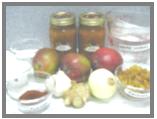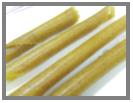The Mango - A Tropical TreatElaine M. D'Sa, Ph.D. |
 |
Mango - the word conjures up visions of exotic summer desserts, gourmet sauces and tropical fruit salads. To those who have lived in areas with mango groves, it brings back memories of trees loaded with the oval fruit, slowly ripening in the warm sunshine, reaching their perfect peak of ripeness before harvest, and getting around the seed, quite literally, to get to the sweet, aromatic pulp.
The mango tree (Mangifera indica, L.) is native to the Indian subcontinent, and has been cultivated for about 4,000 years. It is a tropical or subtropical evergreen tree, and over 1,000 varieties are believed to exist. The mango was first introduced to the U.S. in the 1800s. Mangoes have become increasingly popular in the last decade or so, the perfect balance of sweet, tart and tropical flavors and a smooth texture meets consumer demands for new, fresh and exotic culinary adventures.
Selection, Storage and Preparation:
Most mangoes sold in the U.S. are imported from Mexico, Brazil and Central America, though some are grown in California and Florida. These are mainly of the South-East Asian (Indo Chinese) type, originating in the Philippines and may be 2-9 inches long. Varieties usually available in grocery stores are Tommy Atkins (commercial Florida variety, medium to large thick-skinned fruit, orange-yellow with red or purple areas, medium fiber), Haden (Indian type, mild flavor, low fiber, oval, yellowish-red fruit), Kent (large fruit, greenish-yellow with red areas near stem, no fiber) and Keitt (large green fruit with little fiber).
Mangoes are usually picked and shipped for the commercial market while still green. Most mature from May to September, the largest harvest is in June and July. The fruit of each variety develops to different sizes and growers usually wait for a 'filling out' of the fruit to a certain size, before picking. Unripe mangoes are usually green, but could have a reddish tinge near the stem area. When selecting unripe mangoes for a recipe, choose fruit that are green and uniformly hard, with no skin blemishes.
The fruit is best stored for ripening between 70-75°F (but not below 50°C), which occurs within 3-8 days. Ripe mangoes should be firm to the touch, but should slightly yield to pressure. The skin should be tight, and could have areas of green, yellow and red/orange, but should not be wrinkled. Wrinkly, soft fruit are overripe. The flesh of a ready-to-eat mango should be golden yellow/orange and may or may not have fibers. Low-fiber varieties may be preferred for eating or for use in recipes.
The mango tree is a member of the family Anacardiaceae, which includes poison ivy and poison oak, and some people may be allergic to the pollen, seed or resinous sap and should wear gloves when handling the fruit.
Preparing mangoes for cooking or eating:
Wash mangoes. Place a peeled mango upright on a cutting board, balancing it on the narrow end. (Raw mangoes may be peeled with a vegetable peeler; the peel on ripe mangoes may have to be separated after cutting). The seed is large and oval, extending almost through the entire fruit, with the narrow end at the tip of the fruit. Using a sharp knife, slice the mango flesh away on either side of the seed, leaving 3 pieces - 2 mango 'cheeks', and a central seed covered with little flesh. Let the knife 'find' and shape the cutting motion as the flesh is sliced away from the seed. Now, the flesh can be cut into chunks, and any excess flesh around the seed can be trimmed away and used, as well.
To prepare a mango for eating, it may be advantageous not to peel at the start, scoop the flesh out of the 'cheeks' with a spoon, for consumption.

Uses:
While fresh mango remains a delectable treat, the fruit can be used in several other ways. The consistency of the puréed fruit lends itself to being made into many condiments and delectable treats. It can be made into jams and spreads, curds, butters and fruit leathers. For a savory touch, relishes, salsas, sauces, and chutneys are becoming increasingly popular and sought-after items. Mango slices or chunks may also be frozen. Several of these preserved foods can then be used in everyday dishes including shakes, yogurt, ice cream and baked goods.
Home-preserved mango offerings:
| Mango chutney is a wonderful savory blend of fruit, raisins, vinegar and spices that can be served as a tangy side, or spooned on top of vegetables, fish, meat or poultry. It can also be mixed into cream cheese or sour cream and used as a dip, stirred into mashed potatoes or served on top of hot dogs for a twist to that summer grilling experience. |  |
Mango salsa (Spanish) is a chunky fruit-based alternative to the traditional 'idea' of a salsa. This mixture of mango, bell peppers, onions and spices can be used as a fruity side or a dip.
Mango sauce is a versatile fruit sauce as a dessert or ice cream topping, mixed into milkshakes, or spooned onto mixed fruit.
 |
Mango leather is a nutritious snack-time treat for kids (or adults!) - an alternative to high-calorie store-bought snacks. |
References and additional information can be found at:
| 1. | Narain, N., Bora, P. S., Narain, R., and Shaw, P. E. 1998. Mango. In Tropical and Subtropical Fruits, Ed. Shaw, P.E., H. T. Chan, and S. Nagy. AgScience Inc., Florida, U.S.A |
|
| 2. | California Rare Fruit Grower's Association http://www.crfg.org/pubs/ff/mango.html |
|
| 3. | About Fresh Mangoes: http://freshmangos.com/varieties.html |
Elaine M. D'Sa is Research Coordinator with the National Center for Home Food Preservation, Department of Foods and Nutrition, College of Family and Consumer Sciences, The University of Georgia, Athens.
Images are courtesy of the National Center for Home Food Preservation, The University of Georgia, Athens, GA.
This material is based upon work supported by the Cooperative State Research, Education, and Extension Service, U.S. Department of Agriculture, under Agreement No. 00-51110-9762.
Document Use:
Permission is granted to reproduce these materials in whole or in part for educational purposes only (not for profit beyond the cost of reproduction) provided the authors and the University of Georgia receive acknowledgment and this notice is included:
Reprinted with permission of the University of Georgia. E. D'Sa. 2004. The Mango - A Tropical Treat. Athens, GA: The University of Georgia, Cooperative Extension Service.
References to commercials products, services, and information is made with the understanding that no discrimination is intended and no endorsement by the University of Georgia, U.S. Department of Agriculture and supporting organizations is implied. This information is provided for the educational information and convenience of the reader.